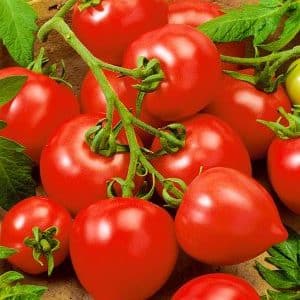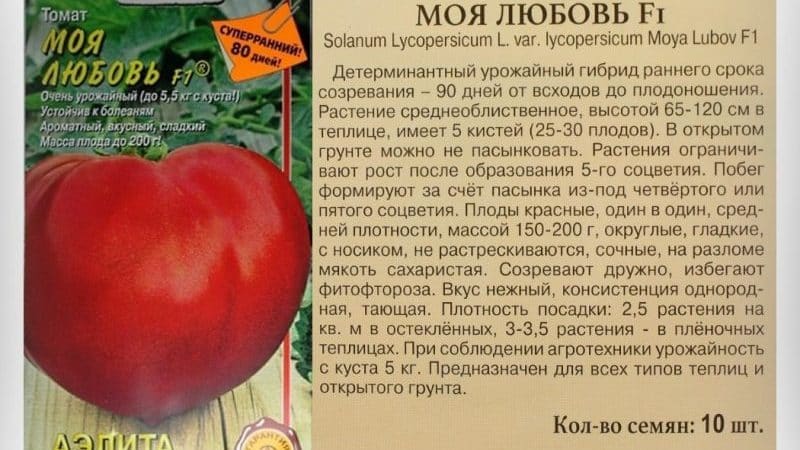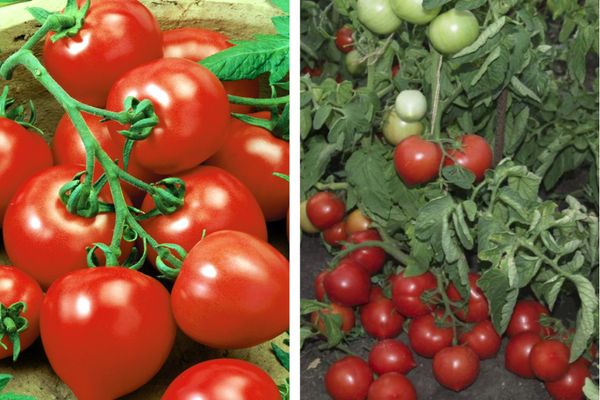Does the “My Love” tomato live up to its name: the pros and cons of the hybrid
The My Love tomato is a super-early, easy-to-care hybrid, especially popular among beginning gardeners. The crop ripens 85–90 days after the first shoots appear. The crop grows and bears fruit equally well in garden beds, in heated and conventional greenhouses, and under film cover.
Description and characteristics of the hybrid
On the branches of the My Love f1 tomatoes, fairly large fruits (up to 250 g), round in shape and bright red in color, ripen. Ripening time is about 3 months (from 95 to 105 days).
The hybrid is determinate: the bushes have limited growth. In greenhouses and greenhouses they can grow up to 1.2–1.4 m. In open ground they grow less: the average plant height is 70–80 cm.
The leaves grow densely, have a standard size and are medium green in color.
Yield indicators
Tomatoes My Love do not have high productivity. With proper care and under film, gardeners receive no more than 8–10 kg of fruit per 1 m², in open ground - no more than 6 kg per season. 3-4 kg of tomatoes are harvested from one bush.
The fruits ripen quickly, so they are picked immediately. With proper care of tomatoes, they get up to 20 kg/m².
Pros and cons of a hybrid
Advantages of culture:
- The skin of the fruits is dense, so they do not crack, can be stored for a long time and transported far;

- high level of productivity among determinate bushes and fruiting until the coldest weather;
- resistance to major crop diseases;
- the possibility of growing in open ground (in the southern regions without film);
- plants can do without regular watering and do not respond to low lighting and sudden temperature changes;
- ripe fruits have excellent taste (juiciness, sourness, sugar content, aroma);
- simultaneous ripening of vegetables.
The disadvantages are:
- dependence of the harvest volume on fertilizers: root and foliar feeding significantly affect productivity;
- the pronounced fresh sourness in the taste may not appeal to lovers of sweet tomatoes;
- the need to tie up plants;
- dense foliage, making it difficult to collect fruits and care for bushes.
How to grow
Let's look at the features of growing tomatoes My Love.
Soil requirements
Prepare the soil for planting by digging it up and loosening it. If the soil is compacted, add a little sand or peat to it. Acidic soil is mixed with dolomite flour or chalk, or lime is added to it (once every 3 years).
Reference! Sprinkle the seedlings with fluffy soil rich in oxygen. It is prepared in advance, before planting.
Sowing rules

Seeds are planted from mid-March to early April. The land is prepared and fertilized in advance.
The largest and strongest specimens are selected from the packaging. To increase germination, they are soaked in a growth stimulator. Some vegetable growers wash grains with a solution of potassium permanganate to prevent fungal diseases and destroy traces of pests. However, the hybrid planting material has already undergone the necessary processing by the manufacturer.
When the seeds hatch and the first 2 leaves appear, the plants are planted in separate containers. The strongest seedlings are selected. After 2 months (late May-early June), the seedlings are planted in open ground.Before this, they are hardened in the fresh air for better adaptation to new conditions.
When growing tomatoes in a greenhouse, sowing is carried out already in early March. Such seedlings will give a good harvest by the end of June.
Planting holes are dug 40 cm apart, the distance between rows is 70 cm. There should not be more than 3 plants per 1 m2. Fertilizers with the elements necessary for the crop are placed in the pits: potassium, nitrogen, phosphorus. The holes are made at least 20 cm deep: they should be larger than the rhizome, which will ensure high-quality picking of plants.
Care after transplant
To grow a good harvest, the crop is properly cared for throughout the summer:
- watered at least once every 5 days;
- tie up bushes to support;
- weed the beds, remove weeds and loosen the soil between the rows;
- prevent plant diseases;
- delete stepsons;
- feed tomatoes.
Despite the fact that the hybrid tolerates temperature changes and drought well, in the first weeks after planting in open ground it needs to be covered with film.
Pinching bushes in a greenhouse ensures the fastest ripening of fruits. In open ground, plants have a stronger stem, so tying it and supporting the branches is not necessary. In ground tomatoes, garters and supports can significantly slow down and prolong the process of fruit ripening.
When cultivating a hybrid in central Russia in open ground, the seedlings are covered with film during the first month after planting. Afterwards it is removed. In the northern regions, the crop is grown only in greenhouse conditions.
The My Love tomato is quite unpretentious in watering and tolerates drought with restraint. Warm water is used for irrigation. Water once every 5 days, in the evening.A day after the soil is moistened, it is loosened and weeded.
Phosphorus and potassium feeding very important for fruit ripening. They fertilize the bushes at every stage of growth. In the future, they switch to complex formulations. Mulching the soil increases productivity and reduces the frequency of loosening the beds.
Tomato clusters, as a rule, form on 7–9 leaf axils. To obtain the desired shape of the fruit, the stepson is left under these clusters: a second stem will form from it. Subsequent stepsons that grow to 6–8 cm are cut off in time.
Attention! When removing the stepson, a small “stump” of 0.5 cm is left to avoid the emergence of a new shoot in this place.
Prevention of diseases and pests

Although the My Love hybrid is characterized by increased resistance to disease, it is sometimes affected by phomosis (bacterial spotting) and blossom end rot. In the first case, HOM and Fitolavin are used for treatment, and in the second case, calcium nitrate is used.
To prevent diseases, seeds are warmed up before planting, watering is moderate, and the greenhouse is regularly ventilated. In the fall, the remains of former plants are burned and the ground is dug up.
The most serious damage to the crop is caused by Colorado potato beetles, whiteflies, mole crickets, and cutworms. Special insecticides are used against them (Prestige, Grom, Confidor and others). For prevention, before planting, seeds are disinfected with potassium permanganate or a mixture of 50 g of aloe juice, 0.5 tsp. honey, a couple of drops of garlic juice and an immunostimulant.
A week after diving into open ground, the plants are treated with a weakly concentrated mixture of boric acid and potassium permanganate.
Another means of prevention is a tincture of nettle, wood ash and horsetail, mixed with a small amount of garlic. The bushes are sprayed with it once a week.
Reviews from gardeners
Marina, Rostov-on-Don: «I use the fruits of this hybrid for preservation. Pleasant sourness and strong peel are perfect for a winter snack. As for cultivation, I personally like that the bushes do not stretch, only about 70 cm. I grow them in open ground. After transplantation, in the first weeks, I cover it with film and feed it. The bushes have significant foliage and fairly dense branching. On average, up to 5 brushes are formed on each, with 5-6 ovaries in each. The fruits are beautiful, as in the photo, round in shape, smooth, and do not crack. Ripening time is early: about 3 months.”
Svetlana, Belgorod: “This is the third season I have been focusing on the seeds of this hybrid. The description and characteristics on the packaging almost completely coincide with the real result. The most important thing is not to be late with planting dates, as this will ensure exceptional taste. Once I made a mistake with planting - the tomatoes were a little brown and were ripening in a box on the shelf.”
Tamara, St. Petersburg: “As a beginning vegetable grower, I bought these seeds to plant in a new greenhouse; not all of them sprouted, but I had enough seedlings. They tried, weeded, watered, fed with simple fertilizers. I can’t say anything special about leaving. I don’t know how to trim branches, so I tied them up instead. We waited about 3 months for the harvest. The fruits grew large and round with a small pimple at the end. The tomatoes are aromatic and tender, I really liked them. Next year I’ll plant them again.”
Conclusion
My Love tomatoes are suitable for growing for both beginners and experienced vegetable growers.The hybrid is easy to care for, does not require regular watering, and can grow in open and closed ground. The fruits are tasty, strong, and have a characteristic pleasant sourness. Suitable for fresh salads and canning. They have excellent transportability.